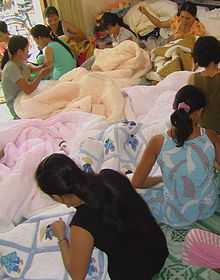Sewing circle
_-_WGA4672.jpg)


A sewing circle is group of people, usually women, who meet regularly for the purpose of sewing, often for charitable causes. For example, in ante-bellum America, local anti-slavery or missionary "sewing circles were complementary, not competing, organisations that allowed [women] to act on their concern for creating a more just and moral society".[1]
Examples of sewing circles include the Fragment Society, and the Mennonite Sewing Circle.
Apart from charitable purposes, contemporary sewing circles may be formed into organisations on a national level, such as the Guilds in Australia and America "for people who regard sewing as a creative and rewarding activity".[2][3]
It has been speculated that the phrase "chew the rag", is related to gossiping while working in a sewing circle.
Other uses
Sewing circle is also a phrase used (by Marlene Dietrich, for instance[4]) to describe the underground, closeted lesbian and bisexual film actresses and their relationships in Hollywood, United States, particularly during Hollywood's golden age from the 1910s to the 1950s.[5] This usage was coined by the actress Alla Nazimova.[6][7]
See also
References
- ↑ Carolyn J. Lawes, ed. (2000). Women and Reform in a New England Community, 1815-1860. Kentucky, US: The University Press of Kentucky. p. 78. ISBN 0-8131-2131-0.
- ↑ "Australian Sewing Guild". Retrieved 3 June 2013.
- ↑ "The American Sewing Guild". Retrieved 3 June 2013.
- ↑ Freeman, David (7 January 2001). "Closet Hollywood: A gossip columnist discloses some secrets about movie idols". The New York Times. Retrieved 18 April 2011.
- ↑ Madsen, Axel (2002). The Sewing Circle: Sappho's Leading Ladies. New York: Kensington Books. p. 3. ISBN 978-0-7582-0101-0.
- ↑ Film Actors: Lesbian, glbtq.com. Retrieved: 2014-01-12.
- ↑ Harbin, Billy J.; Marra, Kim; Schanke, Robert A., eds. (2005). The Gay & Lesbian Theatrical Legacy. University of Michigan. p. 297. ISBN 0-472-09858-6. "Munson was a member of 'the sewing circle,' a term originated by Alla Nazimova for a clique of lesbians and bisexuals who socialized in Hollywood."
Further reading
- Kimberly D. Schmidt, Diane Zimmerman Umble, Steven D. Reschly, ed. (2003). Strangers at Home: Amish and Mennonite Women in History. JHU Press. ISBN 9780801876851.
- Anne Macdonald (2010). No Idle Hands: The Social History of American Knitting. Random House Digital, Inc. ISBN 9780307775443.
- Nancy A. Hewitt (2001). Women's Activism and Social Change: Rochester, New York, 1822-1872. Lexington Books. ISBN 9780739102978.
- Nancy Ruth Reagin, ed. (1995). A German Women's Movement: Class and Gender in Hanover, 1880-1933. Univ of North Carolina Press. ISBN 9780807864012.
- Erica Simmons (2006). Hadassah And the Zionist Project. Rowman & Littlefield. ISBN 9780742549388.
| Look up sewing circle in Wiktionary, the free dictionary. |